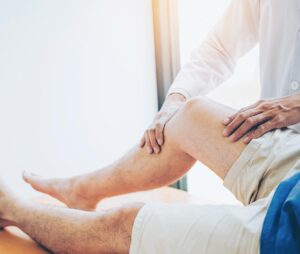 Restless legs syndrome is a common condition characterized by unpleasant limb sensations that are precipitated by rest and relieved by activity. Symptoms are worse during the evening and may result in insomnia. Most cases are idiopathic, although the condition is sometimes familial and may be associated with a range of medical illnesses, including chronic renal failure and iron deficiency anemia. Restless legs syndrome is responsive to several medications, including levodopa, dopamine agonists, benzodiazepines, opioids, and some anticonvulsants. A practical approach to management involves a stepwise plan, commencing with intermittent therapy with less potent agents for mild cases and progressing to medications with greater potency but a higher potential for side effects.
Restless legs syndrome is a common condition characterized by unpleasant limb sensations that are precipitated by rest and relieved by activity. Symptoms are worse during the evening and may result in insomnia. Most cases are idiopathic, although the condition is sometimes familial and may be associated with a range of medical illnesses, including chronic renal failure and iron deficiency anemia. Restless legs syndrome is responsive to several medications, including levodopa, dopamine agonists, benzodiazepines, opioids, and some anticonvulsants. A practical approach to management involves a stepwise plan, commencing with intermittent therapy with less potent agents for mild cases and progressing to medications with greater potency but a higher potential for side effects.
CLINICAL FEATURES
RLS is a clinical diagnosis based on the history of the patient. The six essential characteristics are as follows: unpleasant limb sensations, sensations precipitated by rest and relieved by activity, compelling motor restlessness, symptoms that are worse during the evening or later at night, resultant insomnia, and association with periodic limb movements of sleep (PLMS).
Unpleasant Limb Sensations.—Unpleasant limb sensations are most commonly experienced in the lower extremities, especially in the calves, but occasionally occur in the thighs, feet, or upper extremities. They are usually (but not always) bilateral. The discomfort is often difficult to characterize, and patients often indicate that it is not a pain. It is often described as a deep-seated, creeping, crawling, jittery, tingling, burning, or aching sensation. Frequently, patients report the sensation as indescribable.
Sensations Precipitated by Rest and Relieved by Activity.—The unpleasant sensations are exclusively present (or worsen in severity) while the person is lying or sitting and are relieved, at least temporarily, by activity. Lying in bed is the most common precipitant, but symptoms may also occur while the patient is sitting, especially for prolonged periods such as in a theater, automobile, or airplane.
Compelling Motor Restlessness.—Motor restlessness is associated with a patient’s compelling desire to move the affected limbs. Forcing them to remain still may be impossible and always results in considerable worsening of the discomfort and occasionally causes an involuntary limb jerk. Voluntary activity that may be beneficial involves stretching or jiggling the legs, pacing the floor, or exercising, such as on a stationary bicycle. Massaging the legs or taking hot baths may be effective alternative measures.
Worsening of Symptoms During the Early Evening or Later at Night.—Symptoms are most troublesome while the person is in bed before sleep or during the night. When the person is sitting, symptoms are always most prominent during the evening and are least noticeable in the morning. This phenomenon is probably due to a circadian factor and does not occur only because people tend to rest later during the day.
Resultant Insomnia.—Most patients with RLS have sleep onset or sleep maintenance insomnia, which is clearly due to limb discomfort. In some patients, the symptoms are worst before sleep, whereas in others, they may be most severe later during the night.
Association With PLMS.—PLMS are stereotyped, repetitive flexion movements of the legs during sleep that last 0.5 to 5 seconds and occur semirhythmically at intervals of usually 20 to 40 seconds. PLMS are common, especially in elderly people, and are usually not associated with RLS or any other clinical consequence. Nevertheless, about 80% of patients with RLS will experience PLMS, and often a sleeping partner will describe the movements. PLMS associated with RLS may sometimes cause arousals that fragment sleep and result in excessive daytime sleepiness; occasionally, PLMS without RLS may produce similar effects.
MANAGEMENT
At Alimran Medical Center, we may recommend any of the following treatments
Regenerative medicine treatment (Prolotherapy)
Transcranial direct current stimulation (tDCS)
Steroid injection
- Trigger point injections
- Epidural steroid injections
- Electrical stimulation
- Short and long wave
- Laser therapy
- Ultrasonic therapy
- Magnatic therapy
- Exercises
